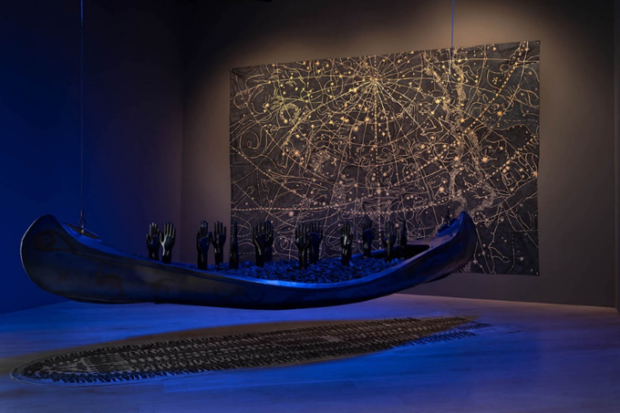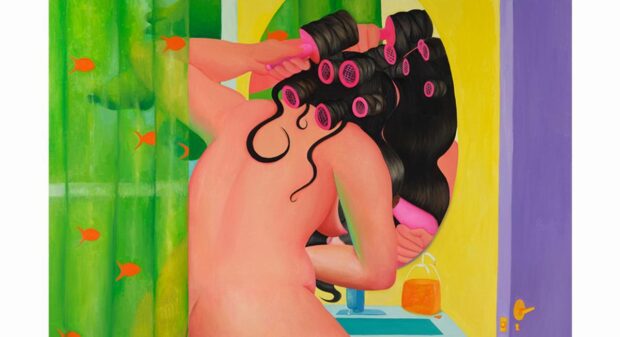The exhibition of Sari Dienes’s work at The Drawing Center (on view October 8 to November 16, 2014) highlighted the artist’s innovative and experimental approaches to mark making in her large-scale rubbings of New York City streets from the 1950s. On November 13, the curators of the exhibition (and current PhD candidates at the IFA), Alexis Lowry Murray and Delia Solomons, led a public tour that introduced Dienes’s work by examining the dynamic interplays of processes and textures in her drawings. During the tour, Solomons and Lowry Murray gave context to Dienes’s practice by underscoring her creative exchanges with contemporaries such as Jasper Johns and John Cage. Following the tour, artists Alison Knowles and Gillian Jagger talked with NYU’s Julia Robinson about their mutual interests in using found forms and textures from natural and urban landscapes in their work.

Sari Dienes (1898—1992) was born in Hungary and was a student of Purists Fernand Léger and Amédée Ozenfant. By 1936, she was Assistant Director of Ozenfant Academy of Fine Arts in London. She moved to New York City in 1939 where she soon befriended artists both established (Mark Rothko) and emerging (Johns and Cage, as well as Ray Johnson, Robert Rauschenberg, and others), many of whose names are listed in pages from the guest book from her studio. On Thursday night, Lowry Murray and Solomons emphasized Dienes’s willingness to experiment with found materials and new processes, and her subversive recoding of established notions of the authorial gesture, qualities that are as important today as they were to Dienes and her contemporaries as seen, for example, in the work of Ray Johnson, Rachel Whiteread, and Rirkrit Tiravanija.

Solomons drew attention to the commingling of natural and carved textures in blue and red scratch marks printed atop visible wood grain in Dienes’s Woodblock VI (Artist’s proof Yaddo) (1953). The delicacy of the rice paper and small scale of the piece create a sense of intimate immediacy enhanced by the subtle edges of the overlapping planes of color. Expanding the scale of these dynamic surfaces, Dienes’s larger drawings such as Grate and Soho Sidewalk (ca. 1953—1955) present long vertical panels of webril fabric onto which the artist directly transferred textures of the streets of New York City using an ink brayer. While her process derived from the Surrealist frottage technique, Solomons was clear to distinguish that Dienes did not transform recorded textures into dream-like figures, as was common practice for the Surrealists. Her ostensibly abstract drawings are revealed to be direct representations of preexisting forms: triangular latticework of subway grates, interlocking hatch marks impressed on metal doors, meandering cracks of aging sidewalks. Dienes’s rubbings render traces of her body’s movement spatially and temporally, as each push and pull of the ink brayer across the rough surfaces of the street both indexed the topography of the place and gradually depleted the artist’s medium. As Lowry Murray explained, rather than assert her authorial dominance, Dienes privileged quotidian forms, drawing attention to the shifting collages of abstract patterns that often pass unnoticed beneath thousands of feet on city streets. The curators evoked Dienes’s social and artistic milieu in a city full of aesthetic possibility by including archival material on their tour: photographs of Dienes making rubbings in the streets, hand-painted exhibition invitations, pages from her guestbook, and photographs of her diverse installation techniques.
Extending themes examined in the tour, Professor Robinson spoke with Gillian Jagger and Alison Knowles about their experimental artistic practices and uses of found objects akin to the trajectory of Dienes’s artworks. In some of her early work, Jagger, too, examined the textures and shadows in New York City streets and both she and Dienes incorporated three-dimensional casts of manhole covers into artworks to be hung on the wall, as in Jagger’s Yellow Line and Time (1963) and Traffic Impressions (1964), and Dienes’s Storm Sewer (ca. 1950s). Jagger explained that she became disengaged with the city and, in 1978, moved to a rural area where she could explore connections between nature and the human body more directly. She spoke of her interests in notions of time, memory, and history conjured by recurring natural motifs in old trees, rock formations, and animal tracks. Such forms amplify the temporal nature of Jagger’s indexical transfers by bridging the primordial and the contemporary: these patterns were observed by ancient people and can still be observed today.

Conceptually similar but materially different from Dienes’s and Jagger’s artistic production, Alison Knowles’s Fluxus event scores reframe ordinary activities and objects as worthy of aesthetic consideration. In her score Make a Salad (1962), cooking becomes a dynamic, aural and visual performance prompting the audience to attune their senses to the sounds and motions of chopping, peeling, arranging—even masticating—for the indeterminate duration of the event. Knowles cited additional examples of how she used unconventional sounds, ranging from the crinkling of flax paper – which she previously incorporated into a performance by making a full-body suit of the material – to the clatter of falling beans in her Giant Bean Turner (2000). The street acted as a locus for art making for Fluxus artists just as it did for Dienes and Jagger; as Knowles explained, she felt she could do something there. Inspired by Cagian notions of chance and indeterminacy, Knowles and her Fluxus collaborators sought out and drew upon the potential energy and freedom of the street in the events of Fluxus Street Theater (1964) and in Knowles’s Street Piece (1962), which instructs: “make something in the street and give it away.”

Dienes, Knowles, and Jagger questioned and expanded notions of what art can be by experimenting with processes and materials in ways that prompt viewers to aesthetically reconsider commonplace forms and activities. Just as Dienes was sentient to the intricate relations between numerous patterns and textures unfurling everyday on city streets, Solomons and Lowry Murray’s tour directed close attention to the complex tensions between representation and abstraction in Dienes’s rubbings from the 1950s, which have often been overlooked. As Dienes explained, “if you’re concentrated on looking for something, then you miss all the things you’re not looking for.” Jagger’s and Knowles’s insights amplified the relevance of Dienes’s open mode of thinking by demonstrating other ways aspects of daily life and nature can be reexamined within new frameworks to yield artworks that speak to the profound importance of constant exploration and experimental questioning.
(To see more of Dienes’s work, the exhibition Sari Dienes: the Spirit Lives in Everything is on view November 20 to December 20, 2014 at Pavel Zoubok Gallery, 531 West 26th Street, New York, NY)











[…] (This article was originally published on November 28, 2014 on the ifacontemporary blog) […]